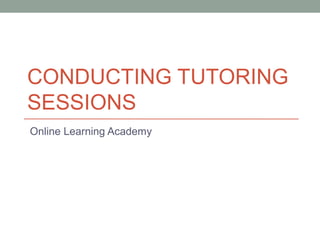
Conducting tutoring sessions
- 1. CONDUCTING TUTORING SESSIONS Online Learning Academy
- 2. Agenda Conducting tutoring sessions Problem set-up First step Questioning strategies Check for understanding Feedback Disengage and support Transitioning tutors General guidelines for tutors Conducting tutoring session checklist
- 3. Problem Setup Look carefully at the problem. Make sure the student has transcribed it correctly. Make sure the student has included all information associated with problem (i.e., graphs, diagrams, etc.) Verify the type of answer needed for the given problem. “OK, so what is it that you’re trying to get for an answer?”
- 4. What is the first step? Ask the student to explain their first step or procedure for solving the problem. Before providing the first step, ask them if they know the proper equation or procedure to use for their problem. If they have no idea, provide the equation or a list of the procedures OR direct them to a website with that information. Prompt the student to use the provided equation to take the first step and other steps that follow.
- 5. Questioning Strategies Asking good questions is an informative process that needs development, refinement, and a lot of practice. •“What do you mean when you say such and such? Explain that a bit more.” •“Can you give an example of this?” •“How would you define this?” •“What does the “I” stand for?” •"How could we prove that?" See “additional resources” for videos on different questioning strategies.
- 6. Check for Understanding To check for understanding have the student re-explain the procedure to you. Avoid asking questions like, "Does that make sense to you?" and "Do you understand now?" Try instead to use questions like “Why do you think this procedure works?” More examples: How does ___ relate to ___? What details can you add to ___? Give me an example of ___? What might you conclude from ___?
- 7. Feedback Reinforce any correct ideas or procedures (e.g. "This part is done correctly", or "You definitely have the right idea here".) Identify incorrect logic and ask the student to consider what else s/he might try. You can provide a hint, but avoid explanations until after the student has attempted a guess. (E.g. "When you evaluate an integral, what do you evaluate first, the upper or lower part?")
- 8. Disengage and Support Disengage (politely, of course)! Encourage the student to work the next problem on his/her own, but let him/her know you can still help. Do not get drawn into working the next problem (and next...) with an insecure student. S/he needs to develop the ability to apply what s/he is learning without your supervision.
- 9. Transitioning Tutors When transitioning a student from one tutor to another, please provide the following information to the new tutor: Whether the student has a headset or speakers and can/can't hear audio. Whether the student is still working on the problem or is done. Whether the student's information is logged in database. If not, provide the information for the new tutor. e.g. “@suzanne – jonah can hear, just starting new problem, info in db”
- 10. General Guidelines for Tutors Guide the student Ask leading questions. Avoid doing the problems for the students. Teach concepts Help students become independent learners. Provide tips for remembering information. Address anxiety Avoid phrases "this is easy" - may intimidate students. Share a struggle of your own to help students relate. Try not to confuse the student If you are unsure of a procedure, ask the student the procedure used by their teacher, ask another tutor to help and use online resources, but try to use similar methods to their class.
- 11. Reminders Greet incoming students immediately. Move students to break-out room right away. If you haven’t tutored in awhile or are new to a shift, step up and take the new student, don’t wait to be asked. No waiting around - everybody is responsible for getting students served quickly and keeping the workload equitable. Don’t hang out it a break-out room unless you are actively tutoring, helping, or observing. If a session ends or a student is working on his/her own, wait in main room and get in the queue to take other students.
- 12. Reminders Respond to requests from Coordinators, Lead Tutors and other tutors right away. The penalty for unresponsiveness in the tutoring room is removal from the schedule for at least one week. If there are tutors NOT responding promptly, save/email the mod chat log as evidence. * You must be responsive at all times means < 2 minutes per response
- 13. Conducting Tutoring Session Checklist Problem setup What is the first step? Questioning strategies Check for understanding Feedback Disengage and support Transitioning tutors Responsiveness